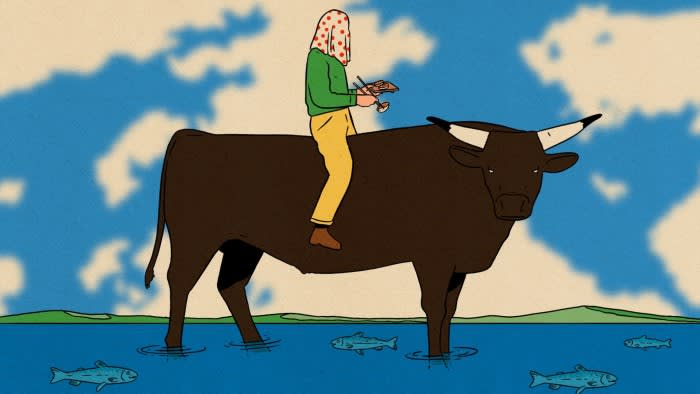
Unlock the Editor’s Digest for free
Roula Khalaf, Editor of the FT, selects her favourite stories in this weekly newsletter.
I’ve hitherto failed at kaiseki. It’s a traditional Japanese formal meal, all about rigour, formality, precision and display. As a result, it’s sometimes referred to as Japanese haute cuisine and usually priced accordingly. This is my problem. Conformity and performative extravagance are the things that piss me off about our own haute cuisine and, once something becomes a trope of “International Fine Dining”, it can surely only drift towards the exclusive and deracinated. I’ve done a fair amount of kaiseki in London. It’s often technically impressive, but it leaves me emotionally cold.
Then a chef tipped me off about Hannah. It’s down on the south end of Westminster Bridge, tucked under the grey Lubyanka of County Hall, and has been there since 2017. A restaurant seemingly untroubled by public attention.
What’s amazing about it is the chef/proprietor Daisuke Shimoyama. No stereotypical, chillingly calm kitchen samurai, the guy is effusive, even passionate, and his strange dining room swerves decisively away from cliché, cod-Zen sterility into a comfortable, almost bohemian space. OK, I’m mixing my cultural references uncontrollably, but here’s the thing: from the second the staff greet you, eyes burning with the zeal to delight, you know you’re in for an uncommon experience.
In my personal rating system, these are the indicators of the best and purest hospitality.
Hassun is the chef’s selection of five small dishes. A gorgeous tour de force. It’s delivered on crockery that promiscuously mixes traditional Japanese ceramics, English “studio” pottery and some superbly junk-shop porcelain. As a combination of Japanese wabi-sabi and enthusiastic culture-mashing, it neatly sums the whole place up. There’s tofu whipped to a cream, topped with raw Scottish langoustine and dressed in oil made from the shells. It helps the staunchest denier understand tofu and nods respectfully to local ingredients. Moving anticlockwise, as recommended, there’s a chawanmushi — set egg custard — with a lump of fatty Iberico ham to flavour it, then shredded and pounded cuttlefish in a citrus dressing. A sticky texture that transubstantiates to velvet on the tongue.
A ceramic cabbage leaf contains roasted shreds of the real thing, dressed like a salad, with two panko-armoured queen scallops on top and at the end, the essential sushi component: a piece of cured mackerel on rice rolled in transparently thin daikon with pickled veg trapped underneath. The assertive vinegar flavour reminds you that sushi is rarely “raw” fish. Tangentially, this tight little spread honours the principal techniques of Japanese cooking: raw/cure, boil, grill, fry and steam. The ingredients and the decorative flowers honour the season.
I could have walked away right then. I could fill three columns parsing Shimoyama-san’s hassun, and I’d have appreciated a fortnight to let my senses catch up — but we’d only just started. (This is the other reason I disliked kaiseki: it’s impossible to cover it all in a thousand words.)
A precise block of seasoned rice draped in a piece of A5 Wagyu beef. What made it exceptional was how it had been shown fire — not to sear, but to free the fats. This was swiftly blanketed with grated foie gras. I’m not a Wagyu fanboy.
I think it’s a gimmick, driven by postwar American influence and little short of a global delusion for chefs and diners, but Shimoyama-san precisely picks out what’s good about it and honours it. Mark me down as a begrudging convert and let me cover my head in a cloth to hide my shame from God.
Tsukuri is the raw course. We’d recognise it as sashimi. Sea bream with a flash-seared tataki-style crust, with a broth made from the grilled frame of the whole fish. This had an almost shocking depth and reminds you just how much time Shimoyama-san is spending obsessing over his dashis and broths. (According to the menu, he studied the differences between the water in Japan and the UK. Jesus, I’m glad he did that back in 2017. These days you can spot British water by the sewage in it.)
The sea bream was followed by Hampshire trout, killed ikejime-style, then lightly smoked. It’s served with tosazu jelly and three lobes of Icelandic uni. I’ve only had urchin roe once before. It was very fresh and resulted in me vomiting all over a rubber boat full of French special forces: a story for another day, perhaps. But on this occasion, with fresh peas, flowers and citrus jelly, it was a far more civilised experience.
Amadai, or tilefish, is cooked by pouring hot oil over the fillet so the scales crisp and stand up like pine needles, a technique called matsukasa-yaki. It sits on a clam stock, subtly thickened to the consistency of a French sauce rather than a Japanese broth. Gimmicky? Only if you’re utterly unimaginative and dropping £500 per head. To me, it was playful and joyous. If it was iconoclastic, it was in the best spirit.
There’s native lobster, grilled and basted with a coral-fortified “umami butter”, then more Wagyu, this time cut into small cubes and charcoal seared, interspersed with raw mushrooms, moistened with a mushroom dashi and crowned with a single morel stuffed with mushroom XO sauce.
I’ve found kaiseki a cold, emotionless luxury. At Hannah, I realised it can be hospitable, creative and warm. But it’s not about the tradition. It’s not about how Shimoyama-san departs from it, or even subverts it. What’s most profoundly attractive is the overt delight he takes in doing it and in bringing it to you. This is the best kaiseki in London. Go immediately.
Hannah
County Hall, Southbank Riverside, London SE1 7PB
12-course omakase: £185
8-course omakase: £125
5-course lunch: £45
Follow Tim @TimHayward and email him at [email protected]
Follow @FTMag to find out about our latest stories first and subscribe to our podcast Life and Art wherever you listen
